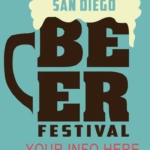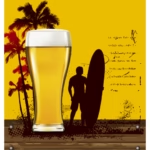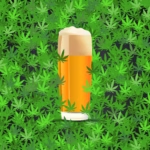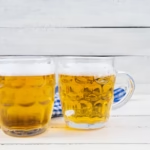Beer is more than just a beverage—it’s a rich tapestry of history, culture, and craftsmanship. Across the globe, countless styles have emerged, each with its unique flavor profile, brewing method, and story. Here are 25 of the most iconic and influential types of beer, from ancient brews to modern innovations.
🍺 1. Pilsner
📜 Origin Story:
In 1842, citizens of Pilsen (now Czech Republic) were so fed up with bad beer that they built a new brewery and hired a Bavarian brewer, Josef Groll. He brought pale malt and bottom-fermenting yeast, and boom—Pilsner was born. Locals were amazed by its golden color and clarity. Josef Groll, by the way, was said to be so grumpy and drunk all the time that no one liked him—except his beer.
🍽️ Best With:
- Grilled bratwurst
- Spicy Thai dishes
- Pretzels and mustard
🎉 Occasions:
- Summer BBQs
- Tailgating
- Watching soccer
😂 Fun Fact:
The original Pilsner Urquell brewery still uses oak barrels. The Czechs drink more beer per capita than any other nation—many say it’s because Pilsner is basically their version of water.
🍺 2. India Pale Ale (IPA)
📜 Origin Story:
British brewers in the 18th century started adding more hops to preserve beer on the long voyage to India. The sailors loved the stuff—some say they got so drunk off it that they lost cargo overboard. Legend has it that officers drank the “real” IPA while the crew got the watered-down stuff.
🍽️ Best With:
- Spicy buffalo wings
- Blue cheese burgers
- Indian curry (yes, it’s poetic)
🎉 Occasions:
- Craft beer festivals
- Game night
- Debates about hop varieties
😂 Fun Fact:
Some IPA fans brag about how bitter they like their beer—there’s even a “Hophead” scale. At one point, brewers competed to make the most ridiculously bitter IPA possible. (Palate destruction became a badge of honor.)
🍺 3. New England IPA (NEIPA)
📜 Origin Story:
Birthed in Vermont in the 2000s, the NEIPA was a rebellion against bitter West Coast IPAs. Instead of bitterness, these beers are juicy, hazy, and loaded with tropical hop aromas. One early brewer said the haze “looked like pond water”—and they loved it.
🍽️ Best With:
- Grilled pineapple skewers
- Fish tacos
- Fruity ceviche
🎉 Occasions:
- Beach days
- Day drinking without shame
- Instagram beer photoshoots
😂 Fun Fact:
Some old-school beer judges refused to rate NEIPAs because they thought the haze was a brewing flaw. Jokes on them—haze became sexy. NEIPA fans will swirl and sniff it like it’s fine wine.
🍺 4. Stout
📜 Origin Story:
Stouts evolved from porters in 18th-century London. Originally called “Stout Porter,” the word “stout” meant strong. Guinness, brewed since 1759, turned it into a global icon. It was even prescribed by doctors and given to nursing mothers (not kidding).
🍽️ Best With:
- Oysters
- Beef stew
- Dark chocolate cake
🎉 Occasions:
- Cold winter nights
- St. Patrick’s Day
- Pub storytelling sessions
😂 Fun Fact:
There’s an old Irish saying: “A pint of Guinness is a meal in a glass.” It’s so thick and dark that people think it has a ton of calories—but it actually has fewer than most IPAs.
🍺 5. Porter
📜 Origin Story:
Porter was the drink of the working class in 18th-century London, especially the porters who hauled goods around the city. It was the first mass-produced beer and even shipped in huge barrels called “butts.” Yes, you could buy a “buttload” of beer.
🍽️ Best With:
- BBQ ribs
- Smoked meats
- Espresso brownies
🎉 Occasions:
- Firepit hangouts
- Historic reenactments
- Fancy pub nights
😂 Fun Fact:
Porters were so popular they were once used to pay workers in beer. One legend tells of a London river turning dark when a porter vat burst and flooded the streets with 100,000 gallons. Locals tried to “save” it… with buckets and mouths.
🍺 6. Saison
📜 Origin Story:
Brewed by Belgian farmers in Wallonia to keep their workers hydrated during summer harvest. Yes, hydrated. Saison was originally low-ABV, rustic, and full of flavor from whatever was lying around the farm—including wild yeast.
🍽️ Best With:
- Charcuterie boards
- Roasted chicken
- Gruyère cheese
🎉 Occasions:
- Spring garden parties
- Lazy Sunday brunch
- Anything outdoors and bougie
😂 Fun Fact:
Farmers used to pay seasonal workers with Saison. Talk about benefits. Also, every Saison tasted different—depends on the farmer’s mood (and yeast in the air).
🍺 7. Witbier (Belgian White)
📜 Origin Story:
Brewed for centuries in Belgium with raw wheat, coriander, and orange peel. The style nearly went extinct until Pierre Celis revived it in the 1960s. Basically, he homebrewed it in his barn and accidentally relaunched a worldwide style.
🍽️ Best With:
- Mussels and fries
- Light salads
- Orange-glazed chicken
🎉 Occasions:
- Poolside hangouts
- Hot weather weddings
- “Not sure what to order” moments
😂 Fun Fact:
Hoegaarden, the most famous Witbier, was originally made in a monastery. Now it’s on tap next to Jägerbombs at college bars worldwide. Bless.
🍺 8. Hefeweizen
📜 Origin Story:
Centuries-old Bavarian wheat beer, once regulated under royal privilege (only certain breweries could make it). The yeast strain produces signature banana and clove flavors. Your first sip might make you double-check the ingredients for bubblegum.
🍽️ Best With:
- Weisswurst and mustard
- Apple strudel
- Sushi
🎉 Occasions:
- Beer gardens
- After bike rides
- Pretending you’re in Munich
😂 Fun Fact:
The name means “yeast wheat.” Germans pour it upside-down (bottle over glass) to get every last bit of the yeast. It’s a whole technique—and people judge you for not doing it right.
🍺 9. Doppelbock
📜 Origin Story:
Created by monks in Munich as “liquid bread” to get through fasting periods (because God said no solid food, not no beer). The first version was called Salvator, which means “Savior.” Holy carbs.
🍽️ Best With:
- Pork roast
- Aged cheese
- Tiramisu
🎉 Occasions:
- Lent
- Cold nights
- Fancy beer tastings where people swirl and sniff
😂 Fun Fact:
Most Doppelbocks end in “-ator” as tribute to the original. Drink enough and you may start chanting in Latin. Bonus points if it’s during brunch.
🍺 10. Amber Ale
📜 Origin Story:
Born from the American craft beer revolution, this was the happy middle child—more malt than pale ale, less booze than barleywine. It helped introduce people to craft beer in the ’80s and ‘90s.
🍽️ Best With:
- Burgers
- BBQ chicken
- Nachos
🎉 Occasions:
- House parties
- Watching baseball
- First dates (safe but cool choice)
😂 Fun Fact:
Amber Ale is like the gateway drug to craft beer. Brewers joke it’s the “training wheels” for IPAs. Balanced, friendly, and everyone has “an amber phase.”
🍺 11. Barleywine
📜 Origin Story:
Started in England as a boozy, strong ale meant to replace wine when times got tough (or imports got expensive). Americans made it hoppier and more aggressive—because of course we did.
🍽️ Best With:
- Stilton cheese
- Braised lamb
- Fruitcake
🎉 Occasions:
- Cold nights in
- Cellar tastings
- Flexing on beer nerds
😂 Fun Fact:
Despite the name, it’s not wine. But it ages like wine. Some people stash bottles for 10+ years like it’s fine Bordeaux. Just don’t chug it unless you’re trying to time travel.
🍺 12. Berliner Weisse
📜 Origin Story:
Napoleon called it “the Champagne of the North.” Originally brewed in Berlin, this tart wheat beer nearly disappeared after WWII, but was revived thanks to hipster brewers who love sour things.
🍽️ Best With:
- Soft cheese
- Fruit tarts
- Shrimp cocktail
🎉 Occasions:
- Rooftop bars
- Picnic blanket drinking
- When beer and lemonade had a baby
😂 Fun Fact:
Traditionally served with a shot of raspberry or woodruff syrup because it was too sour. Imagine giving kids sour candy then offering them sugar. Same energy.
🍺 13. Gose
📜 Origin Story:
From Leipzig, Germany—this salty sour beer disappeared for 50 years and came back as the weird beer darling of the 2010s. Originally brewed with river water that just happened to be salty. Mmmm… nature.
🍽️ Best With:
- Ceviche
- Goat cheese
- Salted caramel desserts
🎉 Occasions:
- Beach drinking
- Hot weather sours
- Tasting flights where someone says “funky”
😂 Fun Fact:
Brewers today add salt on purpose now. The style literally broke German purity law—but it’s too delicious to ban.
🍺 14. Lambic
📜 Origin Story:
Made with wild yeast from the air around Brussels. No added yeast, no rules. Lambics are like controlled chaos in a bottle. Brewers let nature decide how it ferments. It’s basically beer roulette.
🍽️ Best With:
- Brie
- Duck
- Fruit pies
🎉 Occasions:
- Fancy dinners
- Gift giving
- Impressing your snobbiest beer friend
😂 Fun Fact:
Some Lambics age in barrels for years and smell like a barnyard. Yet they taste like sparkling wine and sour candy. Weird? Yes. Beautiful? Also yes.
🍺 15. Gueuze
📜 Origin Story:
A blend of young and old Lambics, then bottle-conditioned like Champagne. Belgian brewers say it’s the “wine of beers.” Takes forever to make and is worth every second.
🍽️ Best With:
- Roasted duck
- Mushroom risotto
- Funky cheeses
🎉 Occasions:
- Beer birthdays
- High-end tastings
- Toasts to obscure hobbies
😂 Fun Fact:
Called “Brussels Champagne” for its fizzy pop. Also, don’t mispronounce it—say “GOO-zeh” unless you want locals to laugh in three languages.
🍺 16. Kriek
📜 Origin Story:
Lambic brewed with sour cherries. Belgian brewers would age it for months with whole fruit. It’s sweet, tart, and intense—like cherry pie in a glass.
🍽️ Best With:
- Duck confit
- Black forest cake
- Cherry-glazed pork
🎉 Occasions:
- Valentine’s Day
- After fancy meals
- Desserty moments
😂 Fun Fact:
Kriek means “cherry” in Flemish. Americans once mistook it for cherry soda, only to find it mouth-puckering. Surprise!
🍺 17. Framboise
📜 Origin Story:
Like Kriek, but with raspberries. Invented by genius Belgian brewers who probably thought: “Why not make a beer that tastes like jam?”
🍽️ Best With:
- Cheesecake
- Chocolate fondue
- Sunday brunch
🎉 Occasions:
- Dessert pairings
- Date night
- Impressing your wine-drinking friends
😂 Fun Fact:
You’ll see the word “Framboise” and think it’s delicate—until the tartness sucker-punches you. In the best way.
🍺 18. Bière de Garde
📜 Origin Story:
French farmhouse ale brewed in winter and “kept” (garde) in cool cellars for summer. It was made to survive the seasons—like Game of Thrones, but with more cheese.
🍽️ Best With:
- Roast chicken
- Camembert
- Savory crepes
🎉 Occasions:
- Picnics in Provence
- Rustic dinners
- Pretending to be French
😂 Fun Fact:
It comes in wine-like bottles with corks and foil. Fancy on the outside, farmhouse on the inside.
🍺 19. Vienna Lager
📜 Origin Story:
Brewed in the 1840s by Austrian Anton Dreher. His invention influenced Mexican lagers (yep, that Modelo you’re sipping is a Vienna cousin).
🍽️ Best With:
- Carnitas
- Schnitzel
- Pizza
🎉 Occasions:
- Oktoberfest alternatives
- BBQs
- Telling people “this is what lagers should taste like”
😂 Fun Fact:
Vienna Lagers are so clean they’re the “introvert extroverts” of beer. Always agreeable. Always underrated.
🍺 20. Märzen / Oktoberfest
📜 Origin Story:
Brewed in March, lagered over summer, drunk at Oktoberfest. That’s the cycle. Once brewed to survive hot months without going bad.
🍽️ Best With:
- Sausages
- Soft pretzels
- Roasted chicken
🎉 Occasions:
- Oktoberfest, duh
- Fall beer gardens
- Polka parties
😂 Fun Fact:
In Munich, you’re served a liter at a time. Some tourists don’t make it to round two. Prost!
🍺 21. Schwarzbier
📜 Origin Story:
Translates to “black beer” but don’t be fooled—it’s smooth and light. A dark lager brewed in Germany since medieval times.
🍽️ Best With:
- Smoked meats
- Grilled mushrooms
- Dark chocolate
🎉 Occasions:
- Winter hangouts
- Fireside chats
- Beer-tasting flights
😂 Fun Fact:
Looks like a stout, drinks like a lager. A true ninja beer.
🍺 22. Scotch Ale / Wee Heavy
📜 Origin Story:
Scottish brewers upped the malt and toned down the hops (because hops didn’t grow well there). They created big, boozy beers meant for sipping by the fire.
🍽️ Best With:
- Haggis
- Roasted game meats
- Bread pudding
🎉 Occasions:
- Highland games
- Snow days
- Wearing kilts (optionally sober)
😂 Fun Fact:
It’s called “Wee Heavy” because of the small glass size—NOT because it’s light. Drink two and try saying “Loch Lomond” correctly.
🍺 23. Kölsch
📜 Origin Story:
From Cologne, Germany. A hybrid style fermented warm and lagered cold. Only breweries in Cologne are legally allowed to call it Kölsch. Beer laws are real in Germany.
🍽️ Best With:
- Grilled white fish
- Salads
- Brie
🎉 Occasions:
- Day drinking
- Easy Sunday sipping
- Weddings
😂 Fun Fact:
In Cologne, waiters will keep refilling your glass unless you put a coaster on top. It’s the universal sign of surrender.
🍺 24. American Pale Ale (APA)
📜 Origin Story:
The American answer to British Pale Ale—born with Cascade hops and bold flavor. Sierra Nevada kicked it off in 1980. A craft beer OG.
🍽️ Best With:
- Fried chicken
- Tacos
- Sharp cheddar
🎉 Occasions:
- Craft beer flights
- Cookouts
- Showing your IPA friend you have taste
😂 Fun Fact:
It’s the middle ground between a lager and an IPA. It’s also the “safe bet” at any brewery. You’ll never regret it.
🍺 25. Rauchbier
📜 Origin Story:
From Bamberg, Germany. Brewed with smoked malt dried over open flames—originally a necessity before modern kilns. Tastes like campfire in a glass.
🍽️ Best With:
- Smoked brisket
- Bacon-wrapped anything
- German potato salad
🎉 Occasions:
- BBQ cook-offs
- Cabin weekends
- “Let’s get weird” beer tastings
😂 Fun Fact:
People either love it or say “WHY does this taste like bacon??” It’s beer’s most delicious controversy.
Conclusion
From the sour complexities of Lambic to the bold bitterness of an IPA, each beer style offers a unique sensory experience rooted in centuries of brewing tradition. Whether you’re a casual drinker or a seasoned connoisseur, exploring these 25 iconic beer styles can open the door to a world of flavor, culture, and history.





Leave a Reply